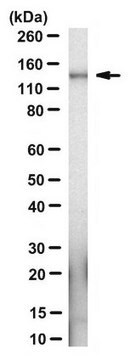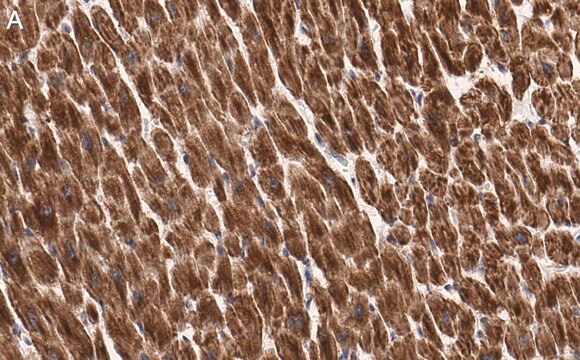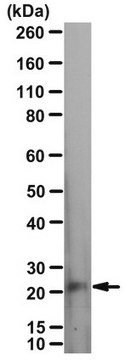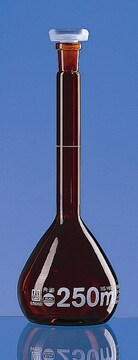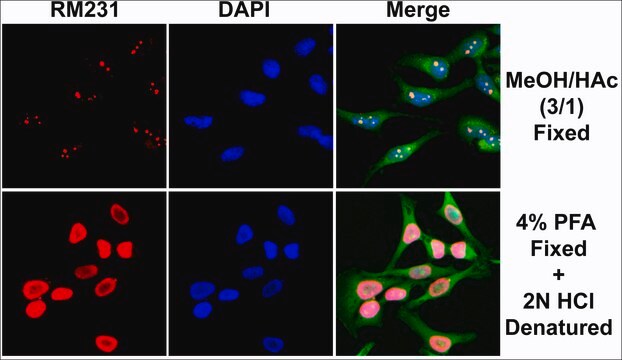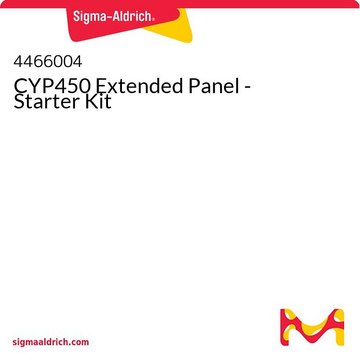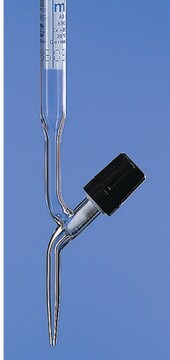おすすめの製品
由来生物
rat
品質水準
抗体製品の状態
purified antibody
抗体製品タイプ
primary antibodies
クローン
18H2, monoclonal
交差性
human, mouse
テクニック
western blot: suitable
アイソタイプ
IgG2aκ
NCBIアクセッション番号
UniProtアクセッション番号
輸送温度
ambient
ターゲットの翻訳後修飾
unmodified
遺伝子情報
human ... APAF1(317)
mouse ... Apaf1(11783)
詳細
Apoptotic protease-activating factor 1 (UniProt: O88879; also known as Apaf-1) is encoded by the Apaf-1 gene (Gene ID: 11783) in murine species. Apaf-1 contains a caspase recruitment domain (CARD), an ATPase domain (NB-ARC), few short helical domains and then several copies of the WD40 repeat domain. It is highly expressed in lung and spleen, weakly in brain and kidney and is not detectable in liver. Under basal conditions it is a monomeric protein, but oligomerizes under apoptotic conditions. The monomeric form is auto-inhibited in a closed conformation through a bound ADP at the nucleotide binding site. Under apoptosis signals ADP is exchanged for ATP and its binding to cytochrome c triggers a conformation change where WD repeat region swings out, which allows the NB-ARC domain to rotate and expose the contact areas for oligomerization. Oligomeric form is a heptameric ring that binds to cytochrome c and ATP and is known as the apoptosome. Oligomeric Apaf-1 mediates the cytochrome c-dependent autocatalytic activation of pro-caspase-9 to mature caspase-9, which then activates effector caspases 3, 6, and 7.
特異性
Clone 18H2 detects Apaf-1 in human and mouse cells. It targets an epitope within the first 97 amino acids from the N-terminal region containing the CARD domain.
免疫原
Epitope: N-terminus
Recombinant fragment corresponding to first 97 amino acids from the N-terminal region of murine Apaf-1.
アプリケーション
Research Category
アポトーシス及び癌
アポトーシス及び癌
Anti-Apaf-1 Antibody, clone 18H2, Cat. No. MABC1187, is a rat monoclonal antibody that specifically detects Apaf-1. It has been tested for use in Western Blotting.
Western Blotting Analysis: A representative lot detected Apaf-1 in Western Blotting applications (Scott, C.L., et. al. (2004). J Cell Biol. 164(1):89-96).
Western Blotting Analysis: A representative lot detected Apaf-1 in Western Blotting applications (Marsden, V.S., et. al. (2006). Blood. 107(5):1872-7).
Western Blotting Analysis: A representative lot detected Apaf-1 in Western Blotting applications (Marsden, V.S., et. al. (2006). Blood. 107(5):1872-7).
品質
Evaluated by Western Blotting in SH-SY5Y cell lysate.
Western Blotting Analysis: A 1:2,000 dilution of this antibody detected Apaf-1 in 10 mg of SH-SY5Y cell lysate.
Western Blotting Analysis: A 1:2,000 dilution of this antibody detected Apaf-1 in 10 mg of SH-SY5Y cell lysate.
ターゲットの説明
~130 kDa observed;141 kDa calculated. Uncharacterized bands may be observed in some lysate(s).
物理的形状
Protein G purified
Format: Purified
Purified rat monoclonal antibody IgG2a in PBS with 0.02% sodium azide.
保管および安定性
Stable for 1 year at 2-8°C from date of receipt.
その他情報
Concentration: Please refer to lot specific datasheet.
免責事項
Unless otherwise stated in our catalog or other company documentation accompanying the product(s), our products are intended for research use only and are not to be used for any other purpose, which includes but is not limited to, unauthorized commercial uses, in vitro diagnostic uses, ex vivo or in vivo therapeutic uses or any type of consumption or application to humans or animals.
適切な製品が見つかりませんか。
製品選択ツール.をお試しください
保管分類コード
12 - Non Combustible Liquids
WGK
WGK 2
引火点(°F)
Not applicable
引火点(℃)
Not applicable
適用法令
試験研究用途を考慮した関連法令を主に挙げております。化学物質以外については、一部の情報のみ提供しています。 製品を安全かつ合法的に使用することは、使用者の義務です。最新情報により修正される場合があります。WEBの反映には時間を要することがあるため、適宜SDSをご参照ください。
Jan Code
MABC1187:
試験成績書(COA)
製品のロット番号・バッチ番号を入力して、試験成績書(COA) を検索できます。ロット番号・バッチ番号は、製品ラベルに「Lot」または「Batch」に続いて記載されています。
N V Srikanth Vallabani et al.
Mutagenesis, 34(3), 265-277 (2019-07-05)
Zinc oxide nanoparticles (ZnO NPs) with their wide range of consumer applications in day-to-day life received great attention to evaluate their effects in humans. This study has been attempted to elucidate the DNA damage response mechanism in a dermal model
ライフサイエンス、有機合成、材料科学、クロマトグラフィー、分析など、あらゆる分野の研究に経験のあるメンバーがおります。.
製品に関するお問い合わせはこちら(テクニカルサービス)